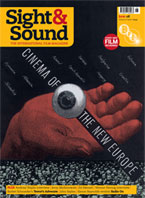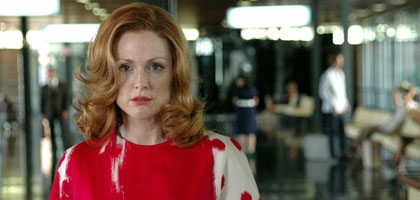
Savage Grace
Spain/USA/France 2007

Reviewed by Lisa Mullen
Synopsis
Our synopses give away the plot in full, including surprise twists.
The story of the disintegration of a wealthy but troubled family is told through five key episodes.
New York 1946. Brooks Baekeland, rich and idle heir to the Bakelite fortune, and his socially ambitious wife Barbara have a fretful night out - Barbara is desperate to make a good impression on her aristocratic fellow diners, but Brooks is alienated and embarrassed. Offended, Barbara, jumps into a passing car and spends the rest of the night with strangers.
Paris 1959. Brooks and Barbara's young son Tony - who narrates the film - is growing up with a strong bond with his mother but he is unhappy. He feels the strain of having to impress his father's friends for his mother's sake, and starts to behave oddly.
Cadaqués, Spain, 1967. Tony, now an attractive young man, begins to experiment with sex and drugs, bringing home his first girlfriend, Blanca. It's clear, however, that there is a strong attraction between Blanca and Brooks.
Mallorca 1968. Blanca and Brooks are now a couple. Barbara seeks solace first through random sexual encounters and then through the friendship of a bisexual walker, Sam, who seduces both her and Tony. Tony is now openly gay and is sleeping with a Spanish drug dealer. He is showing signs of irrational behaviour - he writes his father a letter and takes it to his house, only to bury it in the front garden. On his return home, he gets into bed with both Sam and his mother. Later that year, in Paris, Barbara attempts suicide and Tony nurses her back to health. Their incestuous relationship continues to develop.
London 1972. Barbara appears to be recovering her mental health but after an argument about a lost dog-collar - Tony's treasured keepsake from his childhood - he stabs her to death and is taken away by police.
Review
Sex, money, incest, murder: it may be based on a notorious real-life high-society scandal that rocked the wealthy American heirs to the Bakelite plastics fortune, but Tom Kalin's Savage Grace seems determined to handle the story's explosive ingredients with the utmost circumspection, turning what could have been a sensational melodrama into something much more complex - though not necessarily more successful as a film.
Kalin's portrayal of the dysfunctional Baekeland family (Stephen Dillane and Julianne Moore), a loveless couple hogtied by excessive wealth and aching ennui, and their troubled son Tony (Eddie Redmayne), unfolds in fits and starts, with five key incidents between 1947 and 1972 strung loosely together by Tony's voiceover recollections. The unworkable marriage between frustrated explorer Brooks and his socially ambitious wife Barbara is sketched in quickly, then as quickly falls apart when Brooks falls in love with his son's first girlfriend. This intergenerational role-swapping signals one of the film's major themes, that of misplaced intimacy: Barbara's longstanding taste for casual sex turns out to be the flipside of a longing for closeness that ends up attaching itself to her son, who is ultimately forced to take his father's role as her protector and her sexual partner.
It's difficult to tell this kind of story without simply repulsing your audience. Kalin (whose 1992 Swoon was a key film in the New Queer Cinema movement) attempts to solve the problem by leaving his characters' motivations suggestively - or, if you have a low tolerance for this sort of thing, maddeningly - opaque. Instead, he relies heavily on atmosphere to convey the treacly inertia of the idle rich, all of whom seem to understand very well their essential pointlessness, and evoke it as an excuse for unthinking self-indulgence. This is a key strength of the film's episodic structure - it underlines the fact that very little changes from one decade to the next when your life is a purposeless wasteland. The characters do not age or develop, Kalin seems to say, because they are incapable of doing so.
The performances are uniformly strong: Julianne Moore uses her trademark luminescence to communicate Barbara's ill-concealed hunger for experience and love, and she's a magnetic presence in almost every scene. Stephen Dillane similarly allows Brooks' shiny surface to buckle and bulge with hidden feelings, while Redmayne is perfectly poised as the eerily intense Tony. Hugh Dancy puts in a scene-stealing turn as bisexual walker Sam, who seduces both mother and son; despite being ruthlessly amoral, he's the only beacon of warmth and humanity in this chilly emotional landscape.
It's the froideur of the piece that threatens its success as a piece of film-making. The characters and their milieu are vividly realised, and Kalin makes wonderful use of locations such as a Parisian museum filled with glass cases of stuffed animals, or the organic and intimate grotto where Tony shacks up with his Spanish lover. But he pulls his punches when it comes to the gruesome extent of the Baekelands' pathological family values. There is a line where tact and delicacy cross into limp hesitancy and even cowardice, and Kalin's film comes perilously close to it. As symbolised by the empty dog-collar that Tony carries with him as a talisman of missing affection, this is a film all about absence; but like its subjects, it has an absence of its own at its heart.
Credits
- Directed by
- Tom Kalin
- Producers
- Iker Monfort
- Katie Roumel
- Pamela Koffler
- Christine Vachon
- Screenplay
- Howard A. Rodman
- Based on the book Savage Grace by Natalie Robins, Steven M.L. Aronson
- Director of Photography
- Juanmi Azpiroz
- Edited by
- Tom Kalin
- John F. Lyons
- Enara Goicoetxea
- Production Designer
- Víctor Molero
- Original Score
- Fernando Velázquez
